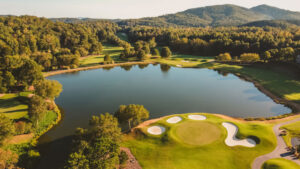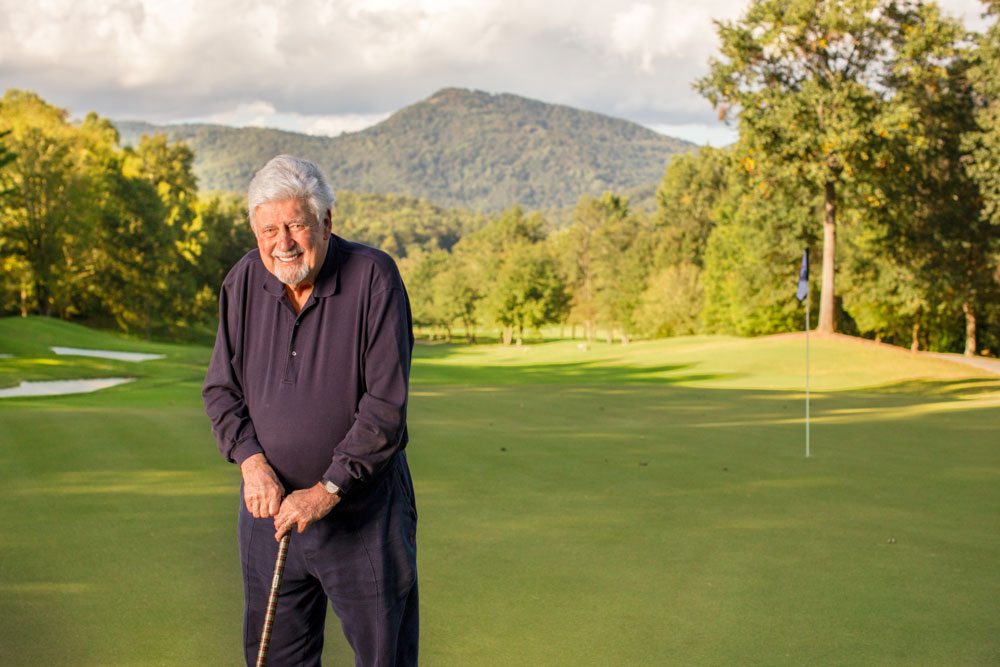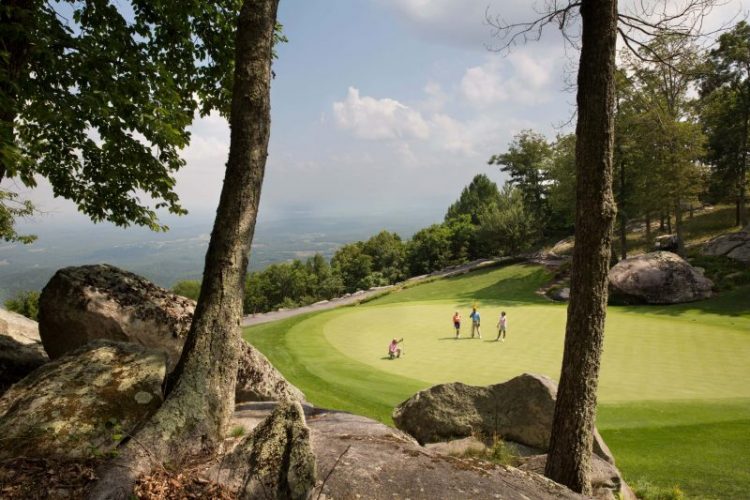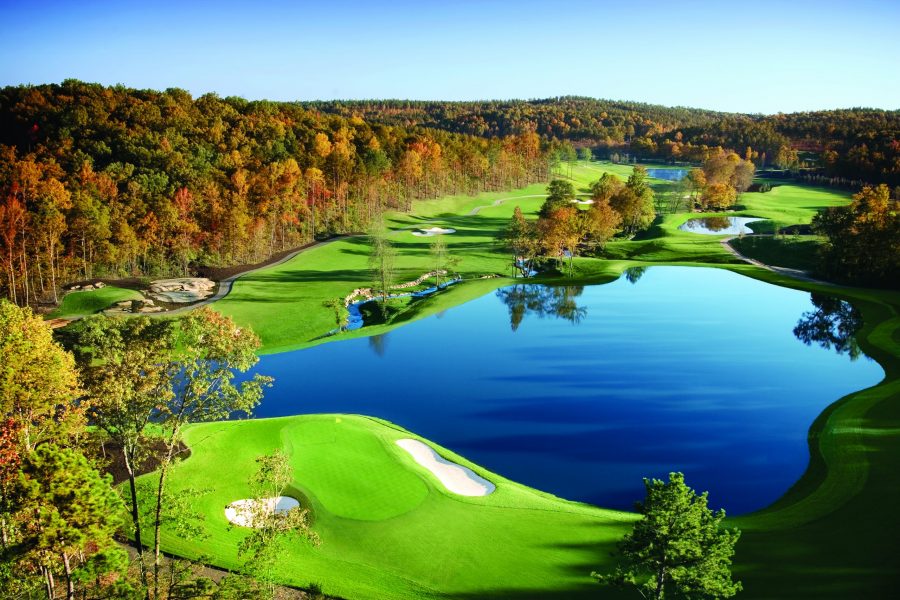Challenging design process yields beautiful, playable golf course at The Cliffs Valley.
It’s 25 years to the autumn day The Cliffs Valley golf course opened for play, and architect Ben Wright comes by to reminisce.
His voice – that Emmy and Peabody Award-winning voice – booms with pride as we stroll along this impeccable, parkland-style course, which Wright designed with a generous assist from Mother Nature.
Wright’s affection for this space remains strong, a quarter century after the celebrated opening match by four PGA Tour winners, and the mood becomes nostalgic as we chat about how the project came together.
Playable by Design
The origins of the Valley design process predate Wright’s involvement. A different golf course designer had initially been tapped and the routing portion of the course was nearly complete when The Cliffs sought out the famed golf commentator, who had designed a few courses in Europe. Wright was already familiar with The Cliffs brand, having voiced a promotional video for The Cliffs at Glassy (his tenure at CBS connected his distinct British accent to the game for decades, much like Nick Faldo’s does today).
Enter the golf mind of Ben Wright, blunt and straight to the point. “I told them, ‘To be honest, you have 15 or 16 blind shots that would make this a very, very hard course to play,’” Wright says, recalling his preliminary review of the soon-to-be-redesigned plans. “I said, ‘If I’m going to do anything for you, it will be user-friendly in the extreme.’”
Indeed, why waste such beautiful space on a course that would only frustrate most golfers? “Don’t ask me to design the hardest golf course in the world … I despise that form of torture for golfers,” Wright says.
The original routing plan called for more than a million dollars’ worth of bridges – something else Wright loathed when analyzing the early design. “I hated that it proposed going backwards and forwards across the creeks,” Wright says.
Stone bridges were ultimately placed throughout the Valley course in a way that ensured efficiency, beauty, and proper use of the design budget.
Natural Beauty
The raw land for The Cliffs Valley project was stunning, and while deciphering the terrain was not without unique challenges, Wright could envision its full potential. Originally a working cattle farm, the property had environmentally sensitive creeks running throughout – so there were conservation concerns to address – and it bordered U.S. Highway 25, so there were noise issues to avoid as well. 
“It was very difficult to build from the point of view of the environmentalists,” says Wright. “But we had great in-house builders. Terrific bridge work and rock work.”
There were other trials, as would be expected. Rain and water sources are critical to keep any golf course in top form but sometimes The Cliffs Valley gets more than its share.
“We were washed out during construction on a regular basis with thunderstorms,” says Wright, noting the drastic change in elevation on two greens from front to back. “I fixed the exhibition match too early; we really opened before we finished No. 2 and No. 10. They washed out most often.”
If you have ever wondered why the cart path follows the creek on hole 14 and ends up two steps off the green, you are not alone. To this day, Wright voices disdain for what he considers a design blunder.
“In my original plans, I had the cart path to the left on No. 14,” says Wright. “But my construction chief – and I never forgave him – decided to route the path across and run it down the creek.”
Wright was off site at the time – “I was away with CBS for 11 weeks with the Tour,” he explains – and by the time he returned, the tweak was already in place.
To much anticipation, The Cliffs Valley golf course opened for play in 1995 and was recognized as one of the year’s best new courses by Golf Digest. Fast forward to present day and enthusiasm remains strong as ever. To ensure this member favorite course stands the test of time, The Cliffs invested in a major renovation in 2017, to the tune of $500,000.
In addition to greens restoration from bentgrass to Bermuda, the project added “Ben’s Bloody Bunker” at No. 8 and repositioned the fairway bunker on No. 9, moving farther from the tee boxes and into the typical drive area. The renovation also reclaimed a fairway bunker on No. 6 in the approach area, and expanded the fairway bunker on No. 12 to stretch more into the fairway and landing area. The No. 1 tee complex changed from three distinct pedestal tees (for the back three sets of tees) to one continuous tee, and it was grassed with Champion Ultradwarf Bermuda.
Passion Play
Wright’s love for the game of golf is steadfast. And he enjoys talking to anyone who will reciprocate the affection.
No doubt, the journeyman’s storied career across the golf industry is legendary. But maybe even more impressive is his stint in the British MI6 unit, where he served as a Russian interpreter during the Cold War. Wright eventually settled in Asheville, North Carolina, in 1982, where he bought a “Leave It to Beaver” home. (The Englishman admits he still has no idea what that means.)
The challenges in the design of The Cliffs Valley golf course never deterred Wright, who had a clear vision for the course from the moment he joined in on the project.
“I always wanted to do the course parkland-style because we had access to a nursery and plundered it for 3,000 trees and 10,000 shrubs,” Wright says. “In fact, the whole idea was a user-friendly golf course that felt like ‘A Walk in the Park.’”
The Valley Clubhouse is reminiscent of Wright’s British roots, too. It was important to him that project included a touch of his motherland’s flair as a focal point.
“I asked The Cliffs to build a clubhouse you might find in England,” Wright says. “If you ever go to London, look up a pub in Fleet Street – Ye Olde Cheshire Cheese – where Charles Dickens used to drink.”
He wanted a replica of its bar at Valley and got it.
For the countless memories made at The Cliffs Valley thus far – and for many more still to come – cheers to you, Mr. Wright. We are chuffed you are forever part of The Cliffs’ family.
This story was featured in Cliffs Living magazine. To read more stories like this one and learn more about The Cliffs, subscribe here.





